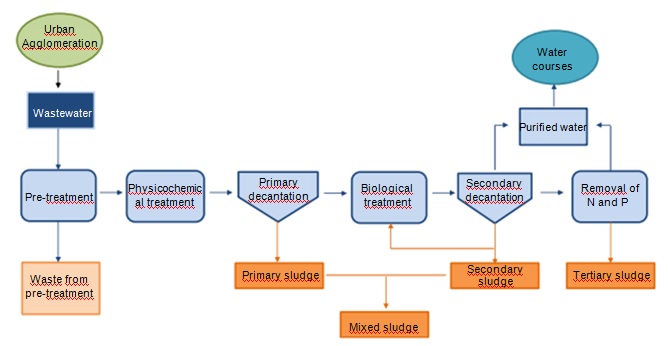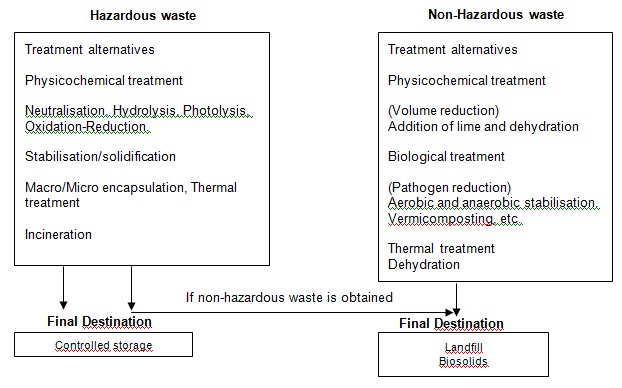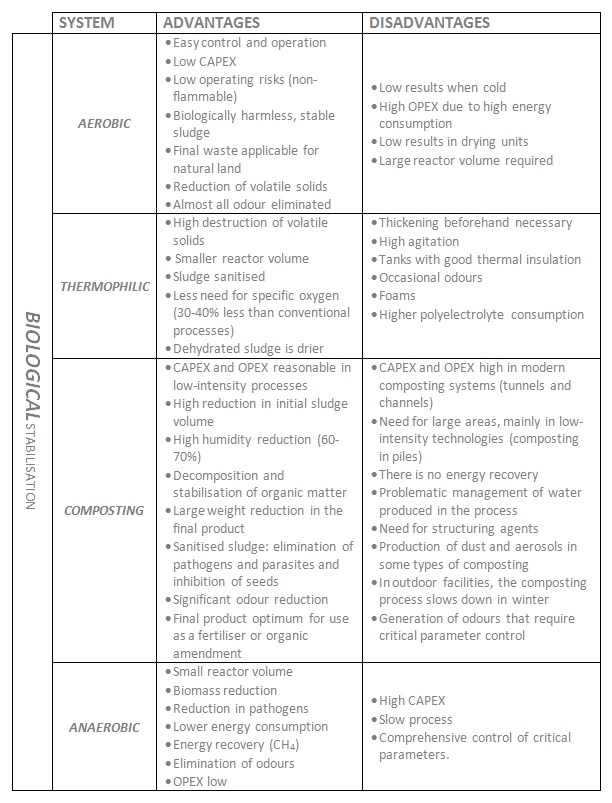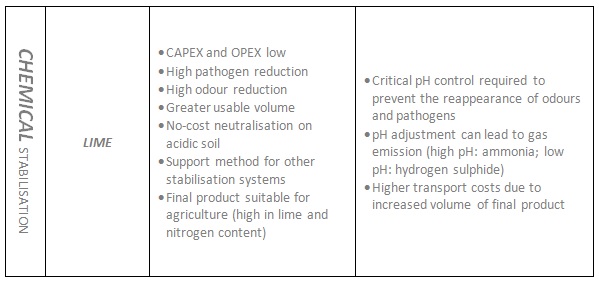At Condorchem Envitech we offer solutions for the treatment of sludge generated during industrial wastewater treatment processes.
Thanks to our systems and processes for the treatment of sludge, the following benefits can be obtained:
- Reduction of the volume and weight of the waste to be sent to the manager
- Reuse of treated water
- Recovery of valuable materials dissolved in the sludge to be treated
- Fertilizer production, thanks to its phosphate and nitrate content
- Energy production (biogas and methane)
- Elimination of health risks associated with sewage sludge
Condorchem Envitech has various processes and technologies for the treatment of sludge, so the selection of the most appropriate system will depend on the peculiarities of each case and the client’s objectives.
The treatment of the sludge generated in wastewater treatment processes is regulated under specific legislation in every country.
CLASSIFICATION OF SLUDGE
The sludge generated during wastewater treatment processes can be classified into 3 types depending on the criteria used:
a) According to the origin of the effluent to be treated
- Urban sludge
- Industrial sludge
b) According to the wastewater treatment stage
- Primary sludge
- Secondary sludge (biological)
- Mixed sludge
- Tertiary sludge (chemical or physicochemical)

c) According to the sludge line treatment
- Thickening: Thick sludge
- Stabilisation: Stabilised sludge (digested)
- Dehydration: Dehydrated sludge
SLUDGE TREATMENT
The sludge to be treated is characterised by various analysis systems, such as chromatography, X-ray fluorescence spectroscopy and bacteriological analysis. Values for the following parameters are then found, which determines the most appropriate treatment processes at their final destination.

Specifically, the parameters that mainly affect the adequacy of the sludge for agricultural use, and which therefore must be analysed before and after the sludge treatment, are:
1) Heavy metals: Cd, Cr, Ni, Hg, Pb, Zn and Cu
Heavy metals are one of the parameters to be taken into account for the characterisation of the sludge. Since the 1970s, there has been a very significant reduction in their content in sewage sludge. This has followed the different legislation that has emerged in the different countries to regulate and limit these elements due to their harmful environmental effects. This has led the industry and the various administrations involved to develop and optimise their management systems to reduce the levels of heavy metals emitted into the environment. The two processes that have contributed most to this are:
- Recycling
- Substitution
Thanks to the development of increasingly optimised technologies and alternative processes linked to both, a very significant reduction of emissions of metals such as Cadmium, has been achieved during the last 30 or 40 years, which has drastically reduced their emission into the environment (http://www.cadmium.org/environment/cadmium-emissions)
2) Pathogenic microorganisms: Salmonella spp, Escherichia coli
3) Agronomic: pH, H Conductivity, Organic matter, NT, org NH3, P, Ca, Mg, K and Fe
4) Organic pollutants: AOS, LAS, phthalates, nonylphenols, polycyclic aromatic hydrocarbons, polychlorobiphenyls, dioxins, furans and brominated diphenyl ethers.
Thus, the sludge line is composed of 3 main treatment stages, within which are different associated processes:
1. Thickening
The processes involved in this stage lead to a reduction in the volume of the sludge to be treated by eliminating water and increasing the concentration of solids. The main objective is to increase the efficiency and financial optimisation of subsequent processes.
The main thickening processes for sludge treatment are based on the following:
- Gravity: The sludge enters in the central area; the thickened sludge collects in the lower part and the supernatant is left in the upper part. This system is used in primary, physicochemical and mixed sludges that decant well by gravity. Biological sludge decants slowly.
- Flotation: The sludge concentrates in the upper part due to the effect of microbubbles, generally of air, upon the solids in suspension, which end up being less dense than the water. This type of system is useful for thickening biological sludge due to its low sedimentation capacity.
- Mechanical: The sludge is concentrated by increasing gravitational forces.
- Centrifugation: Centrifugal force is used to separate mainly biological sludge. The equipment is often expensive and requires adequate maintenance.
- Rotary drum: Separation is by filtration through the rotary drum, and this is used for biological sludge. Operational costs are not high, little space is required and unpleasant odours are not produced.
- Gravity belt filter: The separation occurs by draining the water through a moving porous horizontal belt. This is suitable for active or digested sludge, but not for physicochemical sludge.
2. Stabilisation
Any of the 3 main processes used in the stabilisation of the sludge leads to a reduction in the organic material present to:
a) Reduce pathogens
b) Eliminate odours
c) Reduce or eliminate the rotting capacity of organic material.
The stabilisation processes are divided into
2.1 Biological Stabilisation
2.1.1 Aerobic Stabilisation
This is a biological process to oxidise organic material by microbiological action and oxygen supplied in open digesters. This reduces the final mass of the sludge to adapt it for use in later processes.
It is used as a WWTP secondary treatment without primary treatment, and can also be used for mixed sludge with a higher oxygen supply. The factors affecting this process are:
- Holding time
- Temperature
- Oxygen and mixing needs
2.1.2 Aerophic Thermophilic Stabilisation
This is a thermophilic, self-heating, aerobic digestion developed to meet increasingly stringent regulations. It is based on the conserving the thermal energy generated in the aerobic digestion of organic material from the sludge to reach and maintain the thermophilic temperatures (50-70°C).
2.1.3 Composting
This is a process of biological decomposition and stabilisation of organic material under controlled and aerobic conditions at thermophilic temperatures, as a result of the biologically generated heat. Organic material is decomposed into CO2, water and minerals, resulting in stable, pathogen-free organic material.
It can be carried out only with sludge or by mixing it with structuring agents that facilitate aerobic conditions. The main stages are:
- Mixing
- Fermentation or composting
- Maturation
- Refining
It is effective in the decontamination of organic pollutants such as petroleum hydrocarbons, monoaromatic compounds, explosives, chlorophenols, some pesticides and polycyclic aromatic compounds.
The microorganisms act by mineralising or partially transforming them.
Metal contaminants are not significantly removed during the process. Oxidation and reduction reactions occur which influence solubility, reducing their availability and toxicity in the solid fraction.
Adequate control of the critical parameters (pH, aeration, humidity, C/N ratio) is required to prevent anaerobic conditions in the composting mass which can lead to an increase in unpleasant odours.
2.1.4 Anaerobic Stabilisation
This is one of the most common methods for sludge stabilisation and consists of the degradation of organic material by reaction in the absence of oxygen. This releases energy, methane (CH4), carbon dioxide (CO2) and water (H2O) due to the action of some types of bacteria.
It occurs in 4 stages: Hydrolysis, Acidogenesis, Acetogenesis and Methanogenesis.
These systems are classified into: low load, high load, anaerobic contact and with gas separation. The process must control the following:
- pH
- Temperature
- Sludge supply
- Holding time
- Gas production
2.2 Chemical Stabilisation
This is an alternative to biological stabilisation, whose purpose is to reduce or minimise pathogens and substantially reduce odour-producing microorganisms.
2.2.1 Stabilisation with lime
Mainly lime is added to the sludge at the appropriate dosage to maintain the pH at 12 for a sufficient time (minimum 2 hours) to eliminate or reduce pathogenic microorganisms and those responsible for odours. This below system is normally used:
- Small water treatment plants incorporating sludge for natural land or stored before transport
- Wastewater treatment plants with additional stabilisation requirements
- Supplementary stabilisation system during periods when other systems are out of service
It is normally incorporated before drying the sludge, although it can also be done afterwards using smaller amounts of lime. The dosage of lime depends on:
- Sludge type
- Chemical composition of the sludge (including organic matter)
- Sludge concentration
During the quicklime sludge treatment process, the pH must be kept above 12 for a minimum of 2 hours to ensure the destruction of the pathogens and provide sufficient residual alkalinity for the pH not to fall below 11. This gives sufficient time to store or dispose of the stabilised sludge. The amount of lime needed to stabilise the sludge is determined by its type, chemical composition and solids concentration, which is generally within the 6-51% range. Primary sludge needs the least amount of lime while activated sludge needs the most.
2.2.2 Oxidation with Chlorine
A high dose of chlorine is added to the sludge to be treated in closed reactors and for short retention periods. This system is not currently widespread at an industrial level.


2.3 Conditioning
Gelatinous sludge can make drying operations difficult. In these cases, pre-conditioning is carried out to improve the characteristics of the sludge before dehydration. The most frequent methods are:
2.3.1 Chemical Conditioning
This coagulates the solids and releases absorbed water, and is done before any drying process. The chemicals used are:
- Ferric chloride
- Lime
- Aluminium sulphate
- Organic polymers
The first 3 provide disinfection and stabilisation of the sludge. Polymers have no disinfection capability, but are easier to dispense and often cheaper.
The objective of this type of stabilisation is to reduce or minimise pathogens and substantially reduce the microorganisms capable of producing odours.
2.3.2 Thermal conditioning
The sludge is heated at temperatures of 160-210°C for short periods of time under pressure. This coagulates the solids and changes its structure, by reducing the affinity of the water for the solids in the sludge.
The sludge is sterilised, practically deodorised and with a significantly increased dehydration capacity.
3. Dehydration
This is a physical operation (natural or mechanical) used to reduce the moisture content of the sludge and its volume. Its main objectives are to:
- Increase the dry matter content of the soil by 3-40%
- Reduce transport costs due to volume reduction
- Improve the handling and transportation of the sludge
- Avoid odours
- Increase the calorific value by decreasing the humidity
The most widespread systems are mechanical rather than natural. The cost of dehydration technology is in the following descending order:
- Centrifuges
- Gravity belt filters
- Press filters
3.1 Mechanical Systems
3.1.1 Centrifugal
They consist of a cylinder-conical drum in a horizontal plane based on using centrifugal force to separate the solid phase from the water. There are two types of centrifugation for dewatering sludge:
a) Countercurrent: solids and liquid flow in the opposite direction inside the cylinder.
b) Equicurrent: solids and the liquid fraction run in the same direction.
3.1.2 Press Filter
Press filters consist of a series of vertical rectangular plates arranged one behind the other on a frame. Filter cloths, generally of synthetic fabrics, are placed on the faces of these plates. The space between two plates, in its central hollow, is the thickness the resulting cake will acquire. This thickness can range from 15-30 mm.
The surface of the press filters can be up to 400 m2, and the surface of the plates 2 m2, and they usually consist of over 100 plates. The filtering process is around 25 hours, depending on the duration of the different stages listed below:
- Filling
- Filtering
- Unloading
- Cleaning
This process achieves a concentration of 35-45%, according to the characteristics of the sludge to be treated. Specialised and qualified personnel are needed for the maintenance and operation.
3.1.3 Gravity Belt Filter
The sludge is continuously fed in this system, where this also a chemical conditioning stage, generally with polyelectrolytes.
In the band filter, a gravity drainage is produced and then the sludge is passed through a mechanical application of pressure to produce dehydration, due to the action of the porous fabrics.
It is a cheap method, since it does not need a big initial investment, the maintenance and operation costs are low and the installation represents low energy consumption.
3.2 Natural Systems
3.2.1 Drying beds
This is a natural dehydration system, consisting of layers of drainage materials arranged vertically in an enclosed area.
The sludge passes over layers of gravel or sand, where it is filtered and dewatered due to evaporation. The evaporation depends on the climatic conditions of the area, the time of exposure of the sludge and its characteristics.
The draining material usually consists of 10 cm layers of sand on a 10-20 cm layer of gravel, with a network of pipes underneath to collect the water to be treated in the WWTP. The sand layer must be replenished from time to time as sand is lost in the process of filtering and collecting the sludge.
The disadvantage of this process is the large area of land that is required.